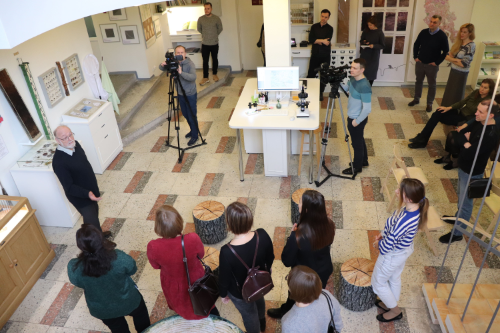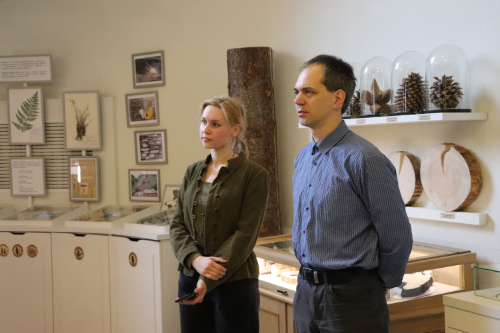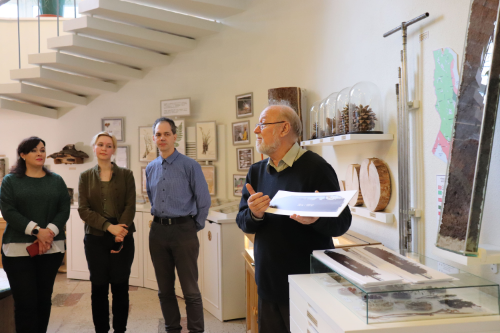– The term "wetlands" encompasses a wide range of ecosystems. This classification includes mires, seacoasts, tidal areas, and shallow waters. Half of our region's territory is wetlands. In fact, mires alone occupy about 30% of Karelia, - says Oleg Kuznetsov, Chief Researcher at the Mire Ecosystems Laboratory of the Institute of Biology KarRC RAS.
The participants of the meeting at the Museum of Applied Environmental Research KarRC RAS were staff of the Kizhi Open-air Museum and Kivach State Strict Reserve and specialists from KarRC RAS subdivisions.
The Mire Ecosystems Laboratory is over 70 years old. Its employees study vegetation, peat deposits, mire development history, investigate past climates starting from the post-glacial era using fossils in peat: vegetation remains, pollen, seeds, etc. As they absorb carbon dioxide and deposit tons of carbon, peatlands play an important role in the carbon balance of the planet. These aspects are also in the focus of scientists' attention. This multidisciplinary laboratory is a leader in its field in the Russian Academy of Sciences system.
The combined area of mires protected within the 82 conservation areas in Karelia is 1566 km2, which is 4.4% of the total area under mires in the republic. Staff of the laboratory also contribute to the designation of new protected areas. E.g., last summer an expedition to the Lizh Peninsula in Lake Onego took place and the value of the area was assessed.

Mire scientists from Karelia work outside of the republic as well. In particular, Head of the Laboratory Stanislav Kutenkov took part in the discovery of a wetland type novel for the mainland Far East – aapa mires. The results of this recent study were published in the international journal Land[href]Land.
Aapa-type mires are open, wide, richly vegetated. They are characteristic of Fennoscandia and occupy substantial territories in Karelia, especially in the north. In the Far East, such mires had previously been known only for Kamchatka.
– Colleagues from Khabarovsk invited me to survey local mires. The Far East is very different from our territory, and mires there are usually of a completely different kind. But the mires that we visited after first studying satellite images proved to be very similar to the ones in Karelia. The most surprising thing is that the flora of those mire is very similar to ours. There are, of course, species with an eastern distribution which do not occur in our area, but the core of the flora is made up of the same sphagnum mosses, dwarf shrubs, and very similar sedges. And the structure itself turned out to be generally similar. However, while aapa is the dominant type of mires in our region, such bogs are very rare over there. And they, certainly, have high vegetation diversity with some quite valuable, red-listed species, - Stanislav Kutenkov recounted.

Museum Manager Alexandra Smirnova and Head of the Mire Ecosystems Laboratory IB KarRC RAS Stanislav Kutenkov
Scientists have thus established that the three mire massifs surveyed in the Khabarovsk Krai have a microrelief structure and vegetation composition similar to those of classical aapa bogs, feature high biodiversity, and are habitats for valuable plant species. Eight moss species novel for the region were identified in the aapa bogs. Experts attribute the genesis of this rare mire type to a change in the hydrology of this area - cessation of floodwater discharge from a large river over wetland surface. The new data will be used in developing the classification of mire vegetation of Russia.
At the meeting in the museum, Oleg Kuznetsov gave a lecture on Karelian mires, and the Museum Manager Alexandra Smirnova introduced the guests to the regular exhibition. In addition, the participants watched a video about the work of mire scientists on the Sambala bog in June 2022. They collected peat samples from a depth of more than 7 meters. Life-size pictures of these peat cores are now also part of the museum's display. The video is available online.




